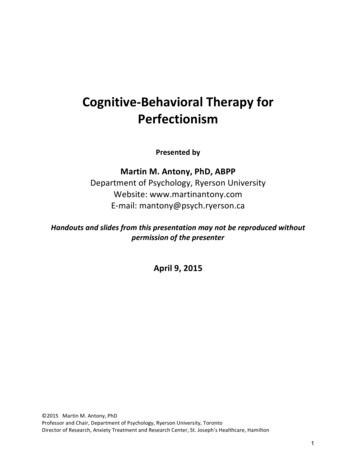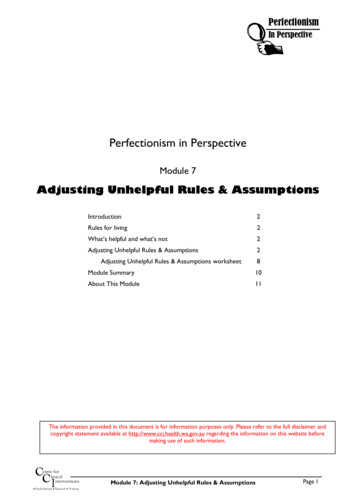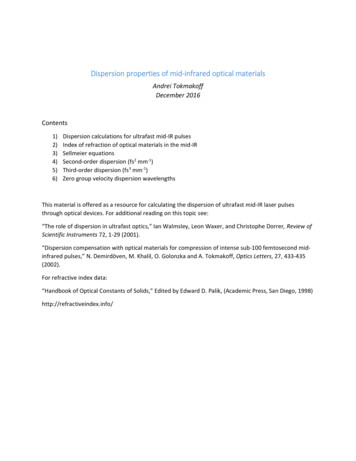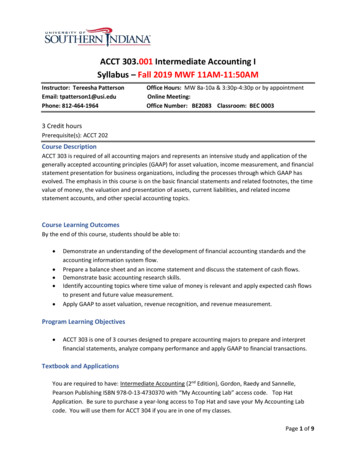
Transcription
Perfectionism - IntermediateMidPositive Psychology in the Classroom1
Lesson InformationPositive Psychology Learning OutcomesStudents will.1.2.3.4.define perfectionismidentify the three types of perfectionismidentify ways to combat perfectionismpractice mindfulness meditation.Language Learning OutcomesStudents will.1. listen for specific information.2. actively participate in conversations through proper responses.3. narrate/describe in past tense about a personal experience.Materials NeededPerfectionism.pptxThe Perils of PerfectionismFailure - Meet the Robinsons - Keep Moving ForwardThe Three flavors of perfectionism.pdfHow to get better at the things you care about EduardoBriceñoPositive Psychology in the Classroom2
OverviewPerfectionism is having unrealistic expectations and thinking andfeeling negatively when those expectations are not met. In otherwords, perfectionism is like a toxic game of Spot the Difference. Wemay compare ourselves to a picture of how we think we should be andidentify all the ways we fail to measure up. This way of thinking isdangerous and destructive. Tell students that today we will talk aboutperfectionism.Activate Background KnowledgeSpot the Difference Game: Show students the two pictures of theEiffel Tower (on the PowerPoint) and give them one minute to studythe pictures and see how many of the 5 differences they can spot. Atthe end of the minute discuss the differences and see if students wereable to identify all 5 differences in the pictures. (Show answer slide.)Positive Psychology in the Classroom3
Retrieved from: https://edtechbooks.org/-tgYIf they focused close enough on the individual elements of the images,students were probably able to successfully find most, if not all, thedifferences in these pictures. However, ask students questions like:During the one minute you were looking for differences in thepictures did you notice the beauty of the picture?Did you think of a time when you may have visited the EiffelTower or about possibly visiting in the future?Did you think about what you know about the history orsignificance of the structure?The purpose of this activity was not to appreciate the images nor tocomplete the second image; the purpose was to identify everyimperfection in the incomplete copy of the first picture.Positive Psychology in the Classroom4
Activity 1: ListeningWatch the following video “The Perils of Perfectionism” and havestudents pay attention and write down the three types ofperfectionism and the three tips to help combat perfectionism.The Perils of Perfectionismhttps://youtu.be/ix6m4vD9KD8After watching the video, have students discuss with a partner thethree types of perfectionism and the tips to combat it. You can askstudents questions like:- Which type of perfectionism are you most prone to?- Can you think of examples of each of the three types ofperfectionism?- What are some ways you use to combat harmful perfectionism?Activity 2: SpeakingHave students work in small groups (3-4 students) and give eachgroup a handout Three Flavors of Perfectionism. Have them read eachof the statements and decide which type of perfectionism it is. Oncepartners/groups have had a chance to complete the activity, reviewthe answers as a class.Activity 3: Listening/SpeakingExplain to students that perfectionism is especially dangerous inlanguage learning. Introduce the following ways in whichPositive Psychology in the Classroom5
perfectionism can bring you down.Ways Perfectionism Brings You Down:Unrealistic goals: Perfectionists tend to set goals that are notattainable, which sets them up for failure.Procrastination: Perfectionism often leads to procrastination.You feel like you can’t start a project until you’ve looked upmore sources, interviewed more people, and come up with thegreatest introduction of all time. The pressure of making thingsperfect keeps you from getting started.Depression and anxiety: Research shows that perfectionismfuels mental health issues such as anxiety and depression.Toxic thinking:All or nothing thinkingSeeing only the bad or the mistake in a situationFocusing too much on the outcome instead of the processretrieved from: https://edtechbooks.org/-BRIBAs a class, discuss some of the ways (listed above) that perfectionismcan bring you down. Tell students that having a growth mindset canhelp combat perfectionism and watch this clip from Meet theRobinsons.Failure - Meet the Robinsons - Keep Moving Forwardhttps://youtu.be/V3UqEps1r5EThen, have students discuss with a partner the following questions:In what ways can mistakes and failure be beneficial?Describe a time when you learned from a mistake and becamebetter.How can taking risks and not being afraid to fail help you be aPositive Psychology in the Classroom6
better language learner?Activity 4: MeditationPlay the 4 minute Good Morning, I Love You video with guidedmeditation and have students join the meditation practice as theywatch. Encourage students to focus and practice self-compassionrather than perfectionism as they actice the Good Morning, I Love You meditation practice everymorning for the week. Be prepared to share with the class the effectthis practice had on your week.Positive Psychology in the Classroom7
Follow-UpTuesday:Perfectionism vs. Doing Things Well. Discuss. If time allows,complete the activity. Perfectionism vs Doing Things Well.pdfActivity taken from: https://edtechbooks.org/-jLTvWednesday:Have students take the Measure of Perfectionism to see where theystand. Measure of Perfectionism.pdfActivity taken from: https://edtechbooks.org/-jLTvThursday:Watch the following video and discuss how this relates toperfectionism. (Video is 11 minutes long. You may choose to watchonly part of the video)https://youtu.be/YKACzIrog24After watching the video, ask students the following questions andhave them discuss it:How can we spend more time in the learning zone?Positive Psychology in the Classroom8
Phillips, M. (2022). Positive Psychology in the Classroom:Lesson Plans for English Language Teachers. logyintheClassroomPositive Psychology in the Classroom9
perfectionism? - What are some ways you use to combat harmful perfectionism? Activity 2: Speaking Have students work in small groups (3-4 students) and give each group a handout Three Flavors of Perfectionism. Have them read each of the statements and decide which type of perfectionism it is. Once










